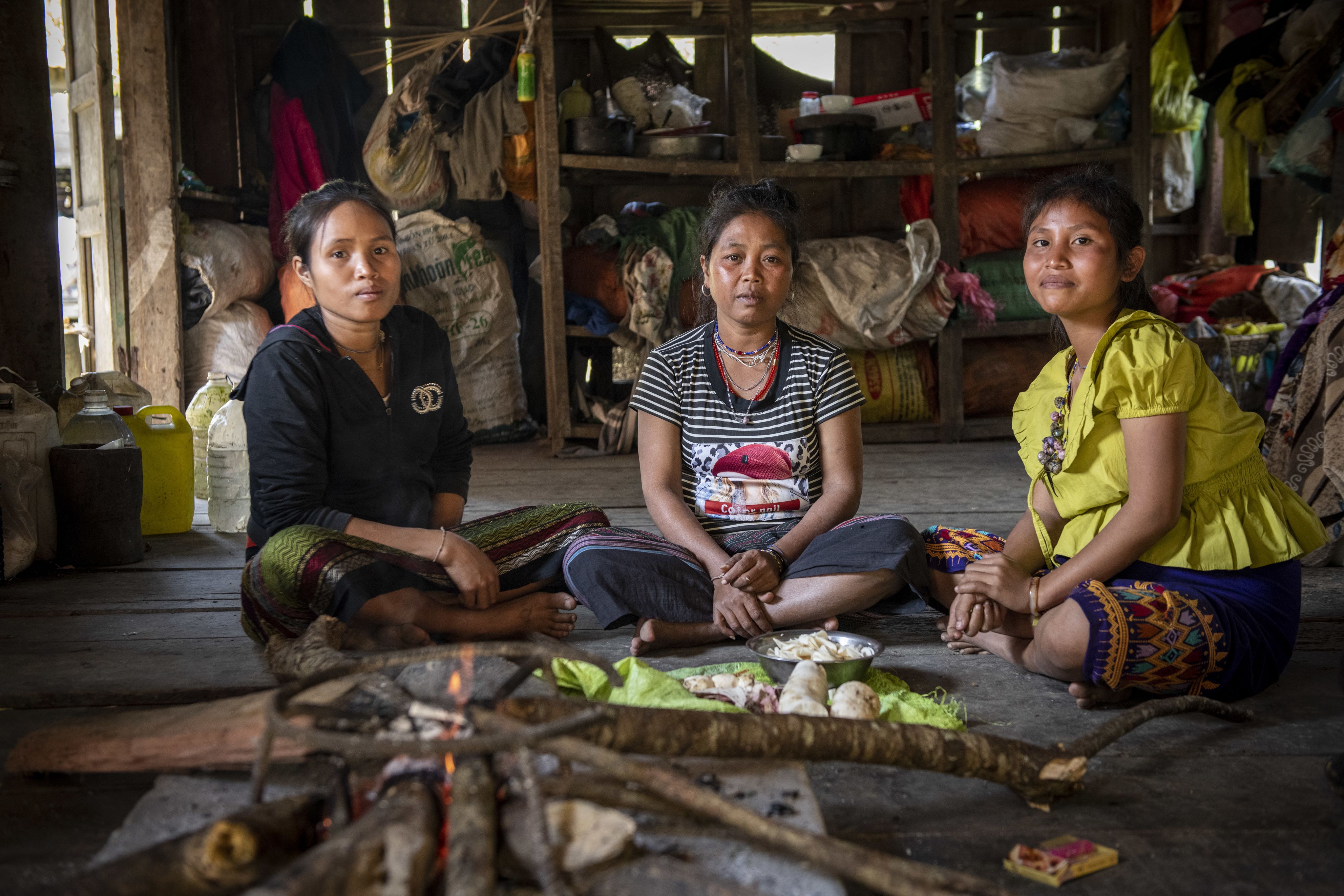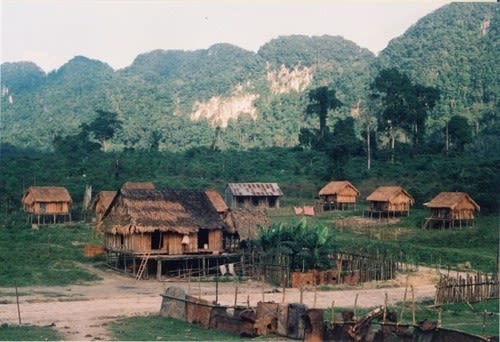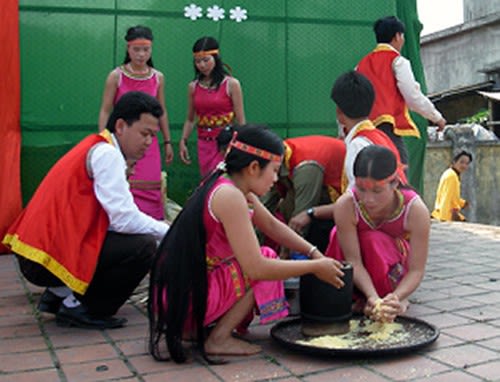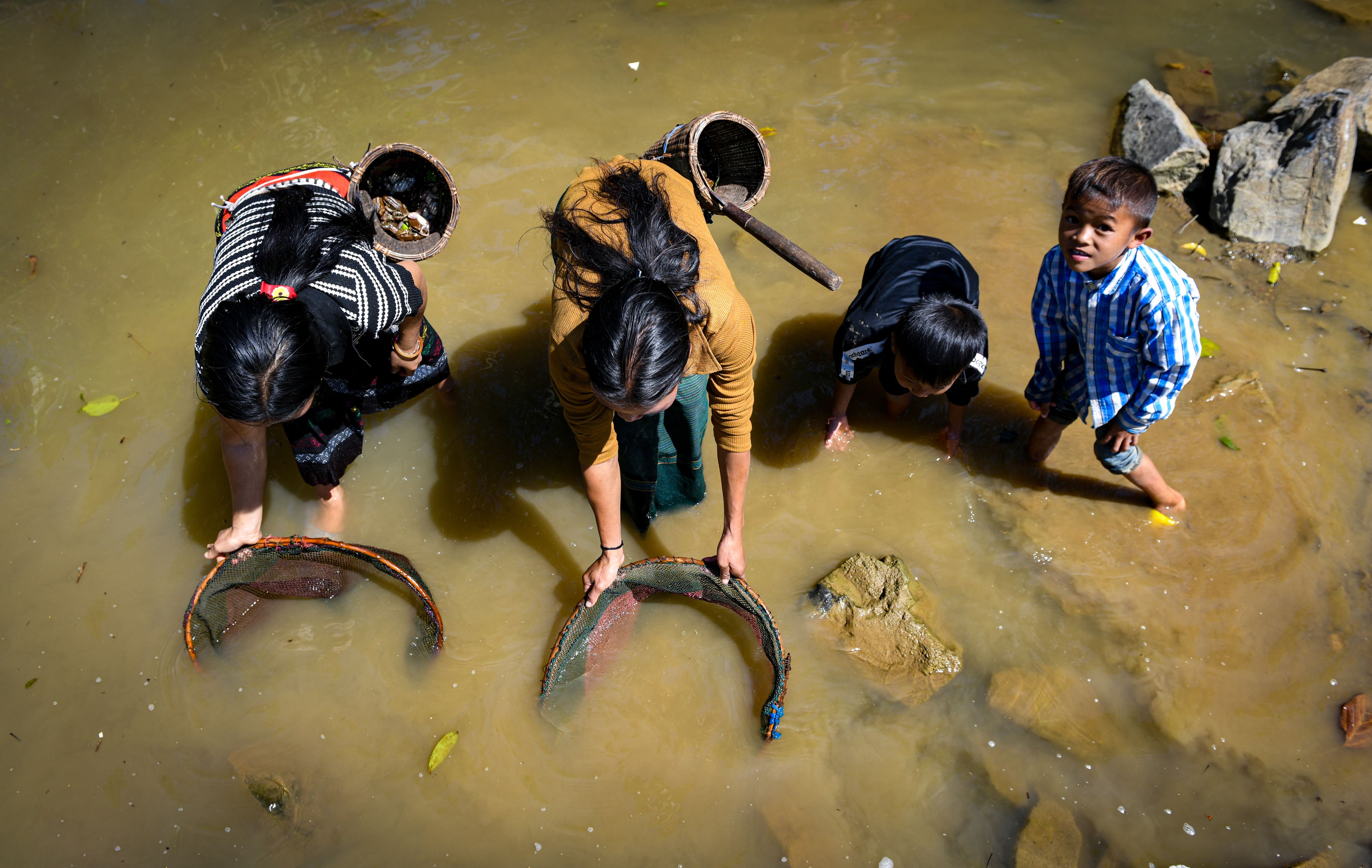
Other names: Ma Lieng, A Rem, Tu Vang, Pa Leng, Xo Lang, To Hung, Cha Cui, Tac Cui, U Mo, Xa La Vang, Ruc, Sach, and May.
Language: The Ruc language belongs to the Viet-Muong language group in the Austroasiatic language family.
Residence: The Chut ethnic group includes the following subgroups: Sach, Ruc, Arem, May, and Ma Lieng; living mainly in mountainous districts such as Minh Hoa, Tuyen Hoa, and Bo Trach in Quang Binh province and a subgroup of Ma Lieng residing in two communes Huong Lien and Huong Vinh in Huong Khe district of Ha Tinh province. This is an area of rugged mountains, and steep hills and is often divided by a dense system of rivers and streams.
History: The ancient homeland of the Chut people was the area of residence of the Vietnamese in the two districts of Bo Trach and Quang Trach, in Quang Binh province. Because of wars and heavy taxes, they had to flee to the mountains to take refuge, some gradually moved deeper into the western region of two districts of Minh Hoa and Bo Trach in Quang Binh province. According to the genealogy of some Vietnamese families in the region, the Ruc and Sach brands have resided in this mountainous area for at least 500 years.
Chut ethnic group
The Chut ethnic group, belonging to the Viet-Muong group, is one of the ethnic minority groups living in the central region of Vietnam. Currently, the socio-economic life of the Chut is gradually improving, thereby narrowing the development gap with other ethnic groups.
History
The ancient homeland of the Chut people was the area of residence of the Vietnamese in the two districts of Bo Trach and Quang Trach, in Quang Binh province. Because of wars and heavy taxes, they had to flee to the mountains to take refuge, some gradually moved deeper into the western region of two districts of Minh Hoa and Bo Trach in Quang Binh province. According to the genealogy of some Vietnamese families in the region, the Ruc and Sach subgroups have resided in this mountainous area for at least 500 years.
Other names: Ma Lieng, A Rem, Tu Vang, Pa Leng, Xo Lang, To Hung, Cha Cui, Tac Cui, U Mo, Xa La Vang, Ruc, Sach, and May.
Geographical distribution
The Chut ethnic group includes the following subgroups: Sach, Ruc, Arem, May, and Ma Lieng; living mainly in mountainous districts such as Minh Hoa, Tuyen Hoa, and Bo Trach in Quang Binh province and a group of Ma Lieng residing in two communes Huong Lien and Huong Vinh in Huong Khe district of Ha Tinh province. This is an area of rugged mountains, and steep hills and is often divided by a dense system of rivers and streams.
Population, language
Population: According to a survey of 53 ethnic minority groups in 2019, the Chut are the 12th least populous ethnic group in Vietnam, with a total population of 7,513 people (including 3,793 men and 3,720 women).
Language: The Ruc language belongs to the Viet-Muong language group in the Austroasiatic language family.

The Chut family is mainly the nuclear family, consisting of two generations of parents and their children. (Photo: THANH DAT)
The Chut family is mainly the nuclear family, consisting of two generations of parents and their children. (Photo: THANH DAT)
Main features
Traditional social institutions: The Chut people call the village "cavel". Each village usually has only seven or ten families of one clan residing. Sometimes families in the same clan reside in different villages. A Chut village is headed by pucaven (village father), a prestigious old man who is experienced in farming and conversant with village customs and habits. Pucaven and old villagers aged 50 or over as his assistants, discuss and settle village affairs such as worshipping rites, harvesting ceremonies and permission for outsiders’ farms in the village area.

A village of Chut ethnic group in Quang Binh. (Photo: dantocmiennui.vn)
A village of Chut ethnic group in Quang Binh. (Photo: dantocmiennui.vn)
The Chut family is mainly a nuclear family, consisting of two generations of parents and their children. The Chut lives in a patriarchal family in which married sons live separately, while daughters live in their husbands’ homes. The man is the head of the family and has the right to decide all the big things in the family.
Housing: Among the Chut ethnic groups, the subgroups of May, Ma Lieng and Arem live in stilt houses, while the subgroups of Sach and Ru live in earthen houses. In the past, when they lived in the forest, Sach Coi, May, and Ruc people all had the custom of living in stone caves near rivers and streams.
Regarding the layout, the house of the May and Ma Lieng people is divided into 3 compartments. Meanwhile, the house of three subgroups Sach, Ruc, and Arem has only two compartments. (Sach and Ruc people call it "can"; Arem people call it "day").
Traditional Cham society is classified into castes like ancient Indian society. They have their own residential areas and have clear separations, including no marriage relationship, no shared neighbourhood, and no same tray.
Religion and belief: Chut people worship their ancestors, gods and worldview. They believe that all things and people have souls, so all five subgroups of the Chut people believe in the presence of gods such as gods of forest, stream, air, earth and rice. In a house, stay a king and a queen in the kitchen.
Costumes: The Chut do not know how to grow cotton and weave fabrics. In the past, the traditional costumes of the Chut people were mainly loincloths and clothes made of trees. Nowadays, Chut people tend to wear clothes according to the Vietnamese or the Khua and Lao people.
Marriage: When a man and woman reach adulthood, they are free in love. The Chut follows monogamy. Before the wedding, the groom’s family must choose a male matchmaker, who has to go to the bride’s family several times before getting their consent for the marriage. The most important wedding offering is dried monkey meat. The Chut have the custom of staying with the groom for 2-3 years after the engagement ceremony.

Chut people cook Poi rice - a traditional dish of the Chut people. (Photo: dantocmiennui.vn)
Chut people cook Poi rice - a traditional dish of the Chut people. (Photo: dantocmiennui.vn)
Cuisine: The main food of the Chut is corn, cassava and rice. They usually eat two main meals, morning (at 6am - 7am) and afternoon (at 4pm - 5pm). At lunch, they often eat boiled potatoes and cassava. When the crop is bad, Chut people still have to eat some tubers and forest fruits instead of rice.
Drinking tea is a long-standing custom of the Chut people. In addition, they also like to drink, smoke and eat betel nuts.
Education: Currently, most Chut ethnic children of school age can go to school. According to the results of the 2019 census on ethnic minority groups, as of April 1, 2019, the percentage of Khmer people aged 15 years and over, who can read and write in general is 64.9%; the net attendance rate for primary school is 101.9%; the net attendance rate of secondary school is 84.7%, the net attendance rate of high school is 42.4%, and the proportion of out-of-school children is 16.4%.

The Chut people live mainly on nomadic farming and hunting, and gathering. (Photo: THANH DAT)
The Chut people live mainly on nomadic farming and hunting, and gathering. (Photo: THANH DAT)
Economic conditions
The Chut people live mainly on nomadic farming and hunting, and gathering. The main cultivars are maize, cassava, beans, and rice. Production tools include axes, sticks to poke holes, ploughs and harrows in the field. Since settling down, the Chut have raised buffaloes and oxen for ploughing. Knitting mainly serves the needs of household consumption. In some places, they also know more about forging knives and axes. Currently, the production economy plays an increasingly dominant role, although life is still difficult, the Chut people are gradually getting rid of poverty and opening up the future of a full life, thanks to wet rice farming; at the same time forming inter-village regions with specific economic forms.
According to the results of the 2019 census on ethnic minority groups, as of April 1, 2019, the unemployment rate among Chut stands at 6.11%, the proportion of labourers working in the non-agricultural sector is 8.4%, the rate of poor households is 60.6%, the proportion of near-poor households is 28.7%, the percentage of households using clean water sources is 39.2%, and the percentage of households using grid electricity for lighting is 85%.